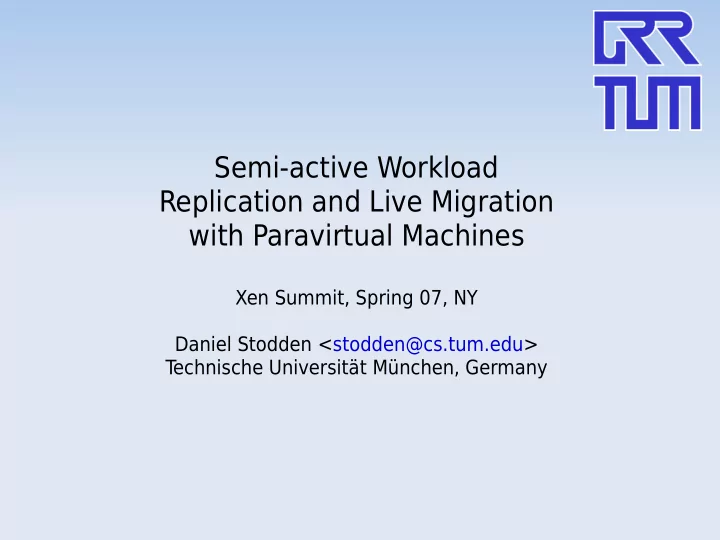

Semi-active Workload Replication and Live Migration with Paravirtual Machines Xen Summit, Spring 07, NY Daniel Stodden <stodden@cs.tum.edu> T echnische Universität München, Germany
S e m i - a c t i v e R e p l i c a t i o n ● Active Replication – Multiple [distributed] instances of one and the same component executing simultaneously ● State machine approach: – same machine state – same input -> same transition, same result state. – But symmetric replicas require consensus ● Semi -active Replication – Asymmetric: One leader, one or more followers ● Control non-determinism ● Leader: Logs any machine 'event' affecting flow of control and data ● Follower(s): Consume and replay the log.
A p p l i c a t i o n ● Fault Tolerance ● Run system until it fails, and beyond. ● Debugging ● Run system until it fails, then finally understand why. ● Intrusion analysis ● Run system until it fails, then see .. whatever. ● ...
Leader Follower Leader Follower Applications Guest OS Xen VMM Xen VMM x86 32/64 x86 32/64 1000Base-TX or Infiniband
W h y V M s ? IPC (SHM, SEM, MSG) Files Pipes (Regular, (Named/ Directory) Unnamed) Process Runtime + Applications Special Files MMIO/PMIO (Block, Char) OS Sockets VM (Unix, TCP, UDP, IP, NetLink, ...) Runtime Environment MEM CPU VMM I/O Conventional process environments are more complex, thereby much harder to Platform control (and maintain).
V M N o n d e t e r m i n i s m ● Synchronous – Driven by VM execution – I/O ● Net/Blockfront drivers ● Console I/O ● System Time: RDTSC ● Asynchronous – Driven by interrupts – Require precise replay on followers ● Differences in the point of delivery produce different state transitions ● Managed with instruction counters (IC) ● VLS: x86 Performance Counters
X e n / V L S : A r c h i t e c t u r e ● Dom0 – Userspace control – XEN_DOMCTL_vls_op ● domU ATTACH ● domU DETACH ● Xen – Trace/Replay Mode ● Determinant Log Transfer – Single Shared Ring – Xen-EventChannel
A p p l i c a t i o n : V M M i g r a t i o n ● Xen 3.0: Clark et al., Cambridge, Live Migration of Virtual Machines, 2005 ● Two Phases 1. Iterative Pre-Copy – Mark & Transmit dirty pages – Iterate – Converges: Writable working set (WWS), due to ref. locality 2. Stop-and-Copy – Suspend VM execution – Migrate WWS – Resume on destination host
W h y d o e s M i g r a t i o n m a t t e r ? ● For VLS – Bootstrapping remote replicas ● xm clone ... With VLS: Maybe aid Migration. ● ● Potentially solve some corner cases Xen Stop-and-copy: ● – Typical service outage: 50 ms (Quake) – 201ms (SPECweb) ● Breaks with excess memory bandwith consumption
D e m a n d M i g r a t i o n ● One alternative: Demand Migration ● Transfer exection to the destination node early ● Fetch missing pages upon demand ● Observations ● Page transmission order respects processing demand ● Stop-and-copy did not ● But transfers are synchronous! ● Request initiates on destination node ● Takes a round trip to answer ● Many missing pages to block on
S e m i - a c t i v e M i g r a t i o n ● Proposed algorithm 1. Iterative pre-copy ● Converge to WWS 2. Switch to”Semi-active mode” ● Activates destination node as a follower ● Source continues as the leader – Running ahead of destination node – Demand transfer of missing pages – Terminates upon memory transfer completion ● Expected properties ● Similar to demand migration – But ahead-of-time page transfer ● Full Service continuity
P r o j e c t S t a t u s ● Mini-OS – Traced & Replayable ● Wallclock and System Time replay ● RDTSC Simulation ● VCPU/Poll/Interval Timers – Verbose Mode (Debug Support) ● Hypercalls, Events pending, ... ● Linux domU currently work in progress – Block / Network / Console I/O – Coming RSN. Well, hopefully ● Repo? http://somacoma.de/~dns/share/hg/xen/vls
Thanks for listening.
Recommend
More recommend